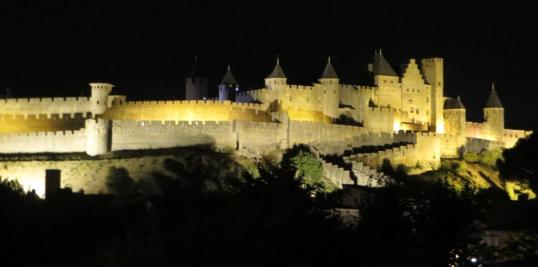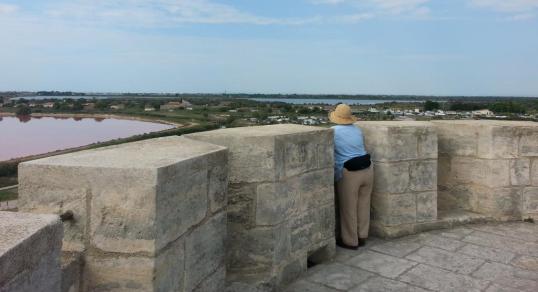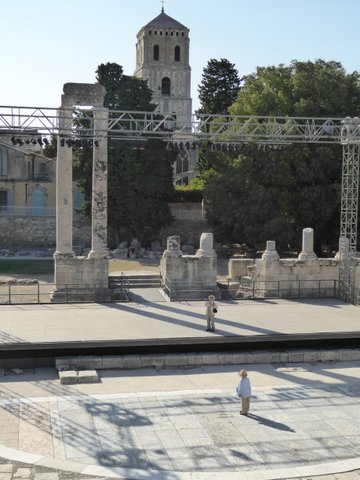Freeway Free in France: Awesome Albi
I had always wanted to go to Albi ever since in college I saw a poster a roommate had, which looked almost other worldly in its having no relation whatsoever to my ideas of Romanesque or Gothic cathedrals. Somehow I missed Albi when I was a student traveler, and when I saw that a small detour could take us there, all it took was to point out that Albi is also the home of the Toulouse-Lautrec Museum to convince my travel mates to make a stop.
 Albi did not disappoint. The cathedral of Ste Cecile is the largest brick building in the world. Brick, not stone, not concrete. It rises from the central plaza in Albi at the side of the Rhone River like some kind of fantasy, all smooth curves and unbroken surfaces. Only slits for Windows. Towers that just keep on going. Our first glimpse had us tripping over our jaws. We walked around from the back of the church looking for the entrance, and found a welcoming Gothic/Baroque carnival of white stone at the top of marble steps leading into the brick fantasy.
Albi did not disappoint. The cathedral of Ste Cecile is the largest brick building in the world. Brick, not stone, not concrete. It rises from the central plaza in Albi at the side of the Rhone River like some kind of fantasy, all smooth curves and unbroken surfaces. Only slits for Windows. Towers that just keep on going. Our first glimpse had us tripping over our jaws. We walked around from the back of the church looking for the entrance, and found a welcoming Gothic/Baroque carnival of white stone at the top of marble steps leading into the brick fantasy. 
Our guidebooks told us that the original cathedral had been build with an uneasy eye to the local Albigensian sect, a group which had been declared heretic by the Pope, but was thriving in Albi. The new bishop designed his cathedral as much as a defensible fortress as a place of worship, just in case the local heretics got rebellious. Only a hundred years after the completion of the vertical cathedral had the welcoming entrance been added.
Once inside, our jaws dropped again. If Escher had combined with Joan Miro and Provençal fabric designers to color the interior of this building, they might have come up with something like this – a riot of pattern and geometry in bright reds, yellows, greens, and blues, ending in arched recesses painted in equally diverse designs, one a yellow sun on a blue field decked with stars, another twining with ivy, etc. 
Most cathedrals draw your eye to the front with a representation of Jesus triumphant at the right hand of God with Mary beaming proudly and all the apostles lined up. How sissified. Ste Cecilia devotes the entire wall to a representation of the Last Judgement, with the apostles, yes, lined up, and then maybe 1/5th of the available space devoted to the saved, in order of rank, with the clergy first, Archbishops and bishops leading, followed by virtuous royalty, and then by the hoi polloi, many of whom have the list of their good and bad deeds hanging in book form around their necks. Some of the dead are still rising from their graves, while the ones who are not saved are already beginning to writhe. The bottom third of the space shows most graphically what kind of punishment awaits the greedy, the lustful, the proud, the gluttonous, the envious, and the slothful. But where is Anger? And where is Christ sitting in judgment? Oops – the Bishops wanted to expand the nave and create a special chapel for themselves, so Christ and the Angry sinners made way for a nicely arched door behind the altar.

After touring the cathedral (a well arranged and narrated audio tour takes about an hour) we went for another outdoor lunch at the Clos de Ste. Cecile, in an former school behind the cathedral. Excellent. More Foie Gras, more goat cheese, more dried duck breast, more walnuts. 
Then we started on the Toulouse Lautrec museum. This is the worlds largest collection of TL, but much of it is devoted to sketches and preliminary studies for the works we have seen in the Musee d’Orsay. Still a lot of information.
We finished our trip with a short stroll around the Bishop’s Garden, a formal boxwood arrangement whose floral elements are changed regularly to reflect the theme of the season. Oddly, this season’s theme was a tribute to Joan Miro, so the floral elements reflected the colors of his painting in non-symmetrical arrangements. Quite interesting once you figured out what they were trying to do.
So far, no hassles, no arguments, no breakdowns, and nothing but sunny (though a bit over-warm) weather. Cross fingers.












 Neglect means no development, so the medieval town, with its defensive wall, royal apartments, and battlements are all pretty much intact, despite some quarrying of the walls to build more modern edifices (pig sties, sheep pens, etc.). Later when the Huguenots were being suppressed by Henry II, a number of them were imprisoned here until they would renounce their heresy. Some stayed for 35 years until finally freed by Louis XV.
Neglect means no development, so the medieval town, with its defensive wall, royal apartments, and battlements are all pretty much intact, despite some quarrying of the walls to build more modern edifices (pig sties, sheep pens, etc.). Later when the Huguenots were being suppressed by Henry II, a number of them were imprisoned here until they would renounce their heresy. Some stayed for 35 years until finally freed by Louis XV.


 Still in Arles
Still in Arles We started off with a stop in the 12th century at the Cloistre de St. Trophies, a cool and calm spot right off the main square. The cloister included many statues which had been so badly eroded you could hardly make them out, but a few that had been sheltered are very human and evocative. Then we walked along the wall of the city overlooking the Rhone, well culverted against flooding, admiring an old Romanesque church which had been converted during the Revolution to a union hall for shepherds, a large domed building which was the remains of a steam bath built by Constantine, and a number of long views down the river to unnamed castles and fortifications in the distance.
We started off with a stop in the 12th century at the Cloistre de St. Trophies, a cool and calm spot right off the main square. The cloister included many statues which had been so badly eroded you could hardly make them out, but a few that had been sheltered are very human and evocative. Then we walked along the wall of the city overlooking the Rhone, well culverted against flooding, admiring an old Romanesque church which had been converted during the Revolution to a union hall for shepherds, a large domed building which was the remains of a steam bath built by Constantine, and a number of long views down the river to unnamed castles and fortifications in the distance.
 Scanning the arena, we spotted her in the Tower! Heading back to the tower, I heard my name called. It was DB, AWOL from the garden, who had just seen WB at the base of the tower. “I’ll meet you at the entrance to the tower, ” she said. By the time we got there, WB was back a quarter of the way around the arena, and DB was nowhere to be seen. And so on. We finally joined forces and made our last tourist stop at the old Roman theatre, much pillaged (as was the Arena) for building materials over the years, but now set up for open air musical and theatrical performances. We tested the acoustics and found them sadly lacking compared to Ephesus in Turkey or the Mormon Tabernacle in Salt Lake City.
Scanning the arena, we spotted her in the Tower! Heading back to the tower, I heard my name called. It was DB, AWOL from the garden, who had just seen WB at the base of the tower. “I’ll meet you at the entrance to the tower, ” she said. By the time we got there, WB was back a quarter of the way around the arena, and DB was nowhere to be seen. And so on. We finally joined forces and made our last tourist stop at the old Roman theatre, much pillaged (as was the Arena) for building materials over the years, but now set up for open air musical and theatrical performances. We tested the acoustics and found them sadly lacking compared to Ephesus in Turkey or the Mormon Tabernacle in Salt Lake City. 

